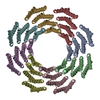+Search query
-Structure paper
| Title | Modulation of FGF pathway signaling and vascular differentiation using designed oligomeric assemblies. |
|---|---|
| Journal, issue, pages | Cell, Vol. 187, Issue 14, Page 3726-3740.e43, Year 2024 |
| Publish date | Jul 11, 2024 |
 Authors Authors | Natasha I Edman / Ashish Phal / Rachel L Redler / Thomas Schlichthaerle / Sanjay R Srivatsan / Devon Duron Ehnes / Ali Etemadi / Seong J An / Andrew Favor / Zhe Li / Florian Praetorius / Max Gordon / Thomas Vincent / Silvia Marchiano / Leslie Blakely / Chuwei Lin / Wei Yang / Brian Coventry / Derrick R Hicks / Longxing Cao / Neville Bethel / Piper Heine / Analisa Murray / Stacey Gerben / Lauren Carter / Marcos Miranda / Babak Negahdari / Sangwon Lee / Cole Trapnell / Ying Zheng / Charles E Murry / Devin K Schweppe / Benjamin S Freedman / Lance Stewart / Damian C Ekiert / Joseph Schlessinger / Jay Shendure / Gira Bhabha / Hannele Ruohola-Baker / David Baker /   |
| PubMed Abstract | Many growth factors and cytokines signal by binding to the extracellular domains of their receptors and driving association and transphosphorylation of the receptor intracellular tyrosine kinase ...Many growth factors and cytokines signal by binding to the extracellular domains of their receptors and driving association and transphosphorylation of the receptor intracellular tyrosine kinase domains, initiating downstream signaling cascades. To enable systematic exploration of how receptor valency and geometry affect signaling outcomes, we designed cyclic homo-oligomers with up to 8 subunits using repeat protein building blocks that can be modularly extended. By incorporating a de novo-designed fibroblast growth factor receptor (FGFR)-binding module into these scaffolds, we generated a series of synthetic signaling ligands that exhibit potent valency- and geometry-dependent Ca release and mitogen-activated protein kinase (MAPK) pathway activation. The high specificity of the designed agonists reveals distinct roles for two FGFR splice variants in driving arterial endothelium and perivascular cell fates during early vascular development. Our designed modular assemblies should be broadly useful for unraveling the complexities of signaling in key developmental transitions and for developing future therapeutic applications. |
 External links External links |  Cell / Cell /  PubMed:38861993 / PubMed:38861993 /  PubMed Central PubMed Central |
| Methods | EM (single particle) |
| Resolution | 3.6 - 13.0 Å |
| Structure data | EMDB-28888, PDB-8f6q: EMDB-28889, PDB-8f6r:  EMDB-28958: CryoEM structure of designed modular protein oligomer C4-131  EMDB-28966: CryoEM map of de novo designed oligomeric protein C4-71_6x  EMDB-28967: CryoEM map of de novo designed oligomeric protein C4-71_8x  EMDB-28968: CryoEM map of de novo designed oligomeric protein C6-71  EMDB-28969: CryoEM map of de novo designed oligomeric protein C6-71_6x  EMDB-28970: CryoEM map of de novo designed oligomeric protein C6-71_8x  EMDB-28971: CryoEM map of de novo designed oligomeric protein C8-71_6x  EMDB-28972: CryoEM map of de novo designed oligomeric protein C8-71_8x  EMDB-28973: CryoEM map of de novo designed oligomeric protein C4-81  EMDB-28974: CryoEM map of designed oligomeric protein C4-71 |
| Source |
|
 Keywords Keywords | DE NOVO PROTEIN / Synthetic / Self-assembling / Oligomeric / Helical repeats |
 Movie
Movie Controller
Controller Structure viewers
Structure viewers About Yorodumi Papers
About Yorodumi Papers







